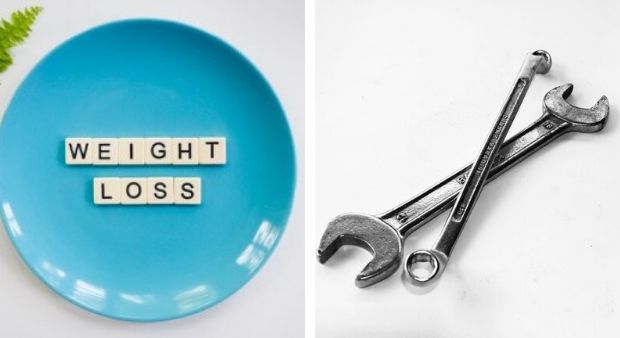I remember the first time I lost a significant amount of weight… and then gained it right back. The year was 2006, I had just turned 21, and the toll of going to the bar every couple of nights with my friends was beginning to show up around my waistline. I bought the South Beach online program, deemed carbs the devil, and got to work on eating chicken, pistachios, ricotta cheese… and not much else.
My confidence soared as I dropped 20 pounds in just a few weeks. Soon, however, I began to realize that I didn’t want to live life without pizza and chocolate.
I gained every one of those 20 pounds back, and then some. As I began working to lose weight again, I tried SlimFast. I had success, until I got sick of drinking a shake for breakfast and lunch. Once again, the weight came back – fast.
Sound familiar?

If you’ve struggled with yo-yo dieting, you know the cycle. You’re elated when the weight melts off, and devastated as you watch it pile back on, pound by pound. You’re constantly torn between being “good,” staying on the straight and narrow, and living a life that allows you to enjoy food.
Believe it or not, you don’t have to choose between the two. It’s possible to enjoy what you eat, indulge from time to time, and still get to a happy, healthy weight for your body. If you’ve gone through cycles of yo-yo dieting in the past, you know that it gets harder and harder to lose weight each time you put it back on.
For many people, this is due to metabolic issues in your body. When you have extreme highs and lows in your weight, your body begins to work as if the availability of food is not predictable for you. In an effort to protect you, your body will slow down it’s metabolism, working to help your body preserve fat, even as you try to lose weight.
While most health and fitness experts agree that the oft-mentioned “starvation mode” only happens when your caloric intake dips to extremely low levels, metabolism slow-down due to years of yo-yo dieting is common.
Let’s take a look at some steps you can take to get your metabolism back on track after years of riding the rollercoaster of the ups and downs of crash diets followed by fast weight gain.
Step 1 – Talk to your healthcare provider.

If you’ve been through the rollercoaster of yo-yo dieting, it’s important to check in with your doctor before you start a new weight loss plan. If you’ve suffered from extreme dips in weight, it’s possible that you may have health issues beyond a slow metabolism.
Talking with your doctor will ensure that you’re doing everything you need to do to take care of weight loss related health issues that have been caused by your dieting ups and downs over the years.
Your doctor will also be able to talk with you about weight loss goals that are a good fit for your lifestyle, age, and body type. There are many things that can affect a healthy weight set point as we age. Your doctor will be able to talk with you about whether your goals are realistic, and how long it may take you to get where you want to go.
While it’s highly likely that you’re healthy enough for regular exercise, your doctor will be able to check and make sure you aren’t dealing with any preexisting conditions that could make exercise dangerous. Once your doctor tells you you’re in the clear to get started with a weight loss program, you can rest assured knowing that your body is ready to handle the hard work it will take to hit your goals.
Step 2 – Get Realistic

It’s easy to say that you want to lose 100 pounds, or run a marathon, or that you want a body like what you see on the cover of the Sports Illustrated Swimsuit Edition – but it’s a different thing entirely. While having ambitious goals is a great way to get started, you’ll want to be sure that what you want to achieve is doable.
It may be helpful to break your goals down into smaller pieces. For example, rather than focusing on losing 100 pounds, focus on losing the first 5 pounds. This can help keep you motivated for the long haul.
Many people who are on weight loss journeys find that it’s more motivating to focus on action goals, rather than weight goals. For example:
- Exercising 5 days each week
- Staying under a caloric goal 6 days a week
- Drinking at least 75 oz. of water each day
- Walking over 10,000 steps each day
When you stay focused on the action items that will increase your chances of long-term success, it can be easier to stay on track.
You’ll also want to think about what you’re willing to exchange to hit your goals – and what you’re not willing to exchange. Setting yourself up for a plan that’s not sustainable is setting yourself up for failure. If you’re willing to get up an hour earlier to get your workout in, fantastic. If you’re not willing to give up your weekly pizza night, that’s ok. Being honest with yourself about what you will and won’t change can help you understand how long it’s going to take you to reach your goals.
Step 3 – Work with a personal trainer and/ or dietitian to discuss your history.

If you’ve tried to lose weight, gained it back, tried to lose it again, just to gain it back – you know how frustrating it can be to even think about beginning the cycle again. It’s a great idea to work with someone who is an expert in the field, and can give you expert advice on what to expect every step of the way.
Be wary of social media health coaches who don’t have any training or certification, as they often offer unhealthy weight loss methods and aren’t properly educated to support you to your goals.
When you meet with your personal trainer and/ or dietitian, talk with them about what you’ve been through when it comes to weight loss. You won’t be the first person they’ve worked with you has struggled with the ups and downs of dieting, and they’ll be able to help you develop a plan that makes sense to get you to your goals. Having someone in your corner who understands the complicated science of what you’re trying to do will help you stay motivated, even when you hit setbacks along the way.
Step 4 – Get moving.

Many people who have been in the world of yo-yo dieting have a love/ hate relationship with working out. You know that it’s important for your health, and you know that working out makes you feel good, but it also makes you hungry. If you’ve ever shunned working out in favor of trying to eat as little as possible, it’s time to get rid of that mentality.
Working out teaches your body that you’re going to be moving and fueling properly, and can go a long way in helping you to overcome metabolic issues. Your workouts shouldn’t be anything too crazy – no need to spend hours on the treadmill – but they should be challenging.
You’ll want to choose an activity that you love (or at least, an activity that you don’t hate). Whether that means signing up for a workout class with friends, doing yoga at night after the kids have gone to bed, or playing soccer in an adult league, find something that you look forward to. When you like exercising, you’re much more likely to stick with it long-term.
Step 5 – Get your sleep.

Don’t feel like you’re being lazy by getting more sleep – in fact, you’re doing the opposite. Getting a solid eight or nine hours of sleep can go a long way in helping your metabolism get back on track.
Rest is a key part of any healthy weight loss process. Studies show that when you get enough rest, your body is better able to control the hormones that indicate hunger, making it easier for you to stay on track with your nutrition plan.
It’s not just about the quantity of your sleep, however. You also need to consider the quality of your rest. If you’ve ever looked for a good reason to make your bedroom a peaceful oasis, consider the fact that doing so can contribute to your weight loss efforts the green light for swiping your credit card. Blackout curtains, noise machines, a diffuser for lavender, and high thread count sheets are all great ways to step up the quality of your sleep.
Step 6 – Hydrate.
Drink up! Aim for at least half of your body weight in ounces of water each day. For example, if you weigh 200 pounds, aim for at least 100 oz. of water. I know what you’re thinking – if you up your water like that, you’ll never leave the bathroom. Rest assured, your body will adjust quickly, and it’s ok to increase your water a little bit at a time.
Studies show that drinking 17 oz. of water can set your metabolism on fire for the next 60 minutes. This effect may be even greater if the water is cold.
Try to stay away from drink flavorings that include artificial flavors or colors, or artificial sweeteners. If you want to flavor your water, do so with lemon or lime. While carbonated waters are all the rage, pay attention to how they make you feel. For many people, carbonation can cause stomach upset and bloating. Your water should be making you feel better, not worse.
Step 7 – Track progress often.

The scale can feel evil, can’t it? Work to come to peace with the idea that the scale is data – nothing more, nothing less. Knowing what you weigh gives you valuable information about whether what you’re doing is moving your closer to or further from your goals.
It can also help inform you of your next steps for your weight loss.
If the scale isn’t a good fit for your emotional health, come up with another way to track your progress. Whether that means taking measurements, taking pictures, or trying on an old pair of pants, you’ll want to check in regularly to ensure that you’re moving toward your goals.
Don’t just rely on methods that show whether you’re getting smaller – you’ll also want to check in on methods of measurement that show how you’re becoming more fit. Track your weights for your workouts. Keep an eye on how fast you can walk or run a mile. Seeing these progressions can go a long way in keeping you motivated, even during times that the scale gets stuck.
Step 8 – Check your motivation.
Love watching weight loss competition shows on TV? You might want to reconsider. When you watch people use non-sustainable methods to hit their weight loss goals, you may feel like you’re not doing enough to get where you want to be. Instead, find role models who achieve and maintain a healthy, fit body in ways that are in line with what’s doable for you.
This might mean linking up with friends at the gym, joining an online community, or talking with your personal trainer about what they do to stay on top of their fitness game. Having someone who achieves their fitness in a healthy way to look up to can go a long way in helping you stay focused.
Step 9 – Reset your stress levels.

If you’ve ever gone to town on an entire pizza after a bad day, you know how stress can ruin your efforts. It’s key to develop a method of stress management that makes sense for you. Whether that means meditation, going to church, venting to a friend, or another way of getting your stress out, be sure to attack your stress before it becomes overwhelming. Doing so can be the difference between dealing with a bad day and wrecking all the hard work you’ve done over the past week.
Other Articles:
How to Boost Your Metabolism After 50?
How to Keep Metabolism High While Fasting
How To Do Metabolic Confusion? – Best Methods To Confuse Your Metabolism

